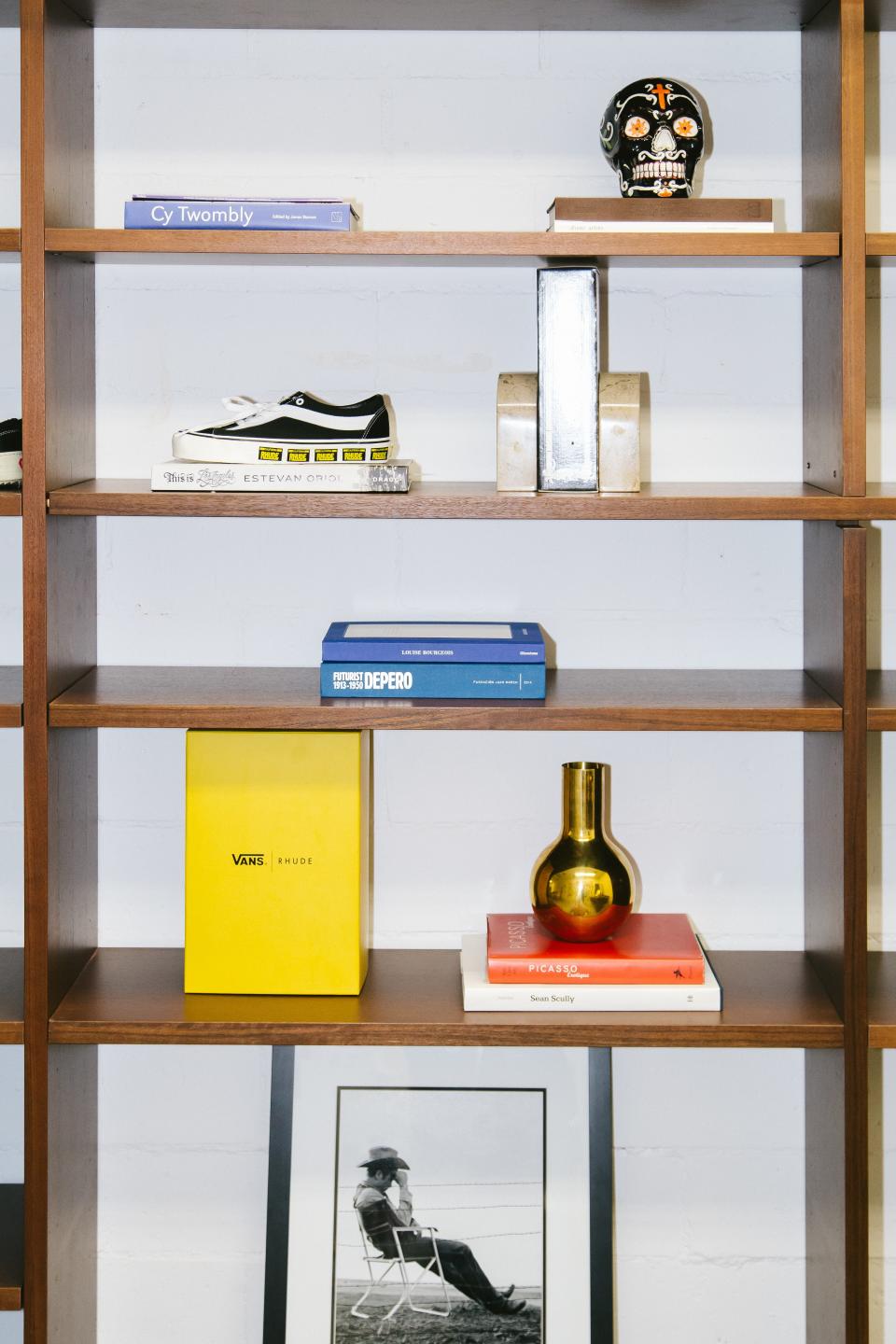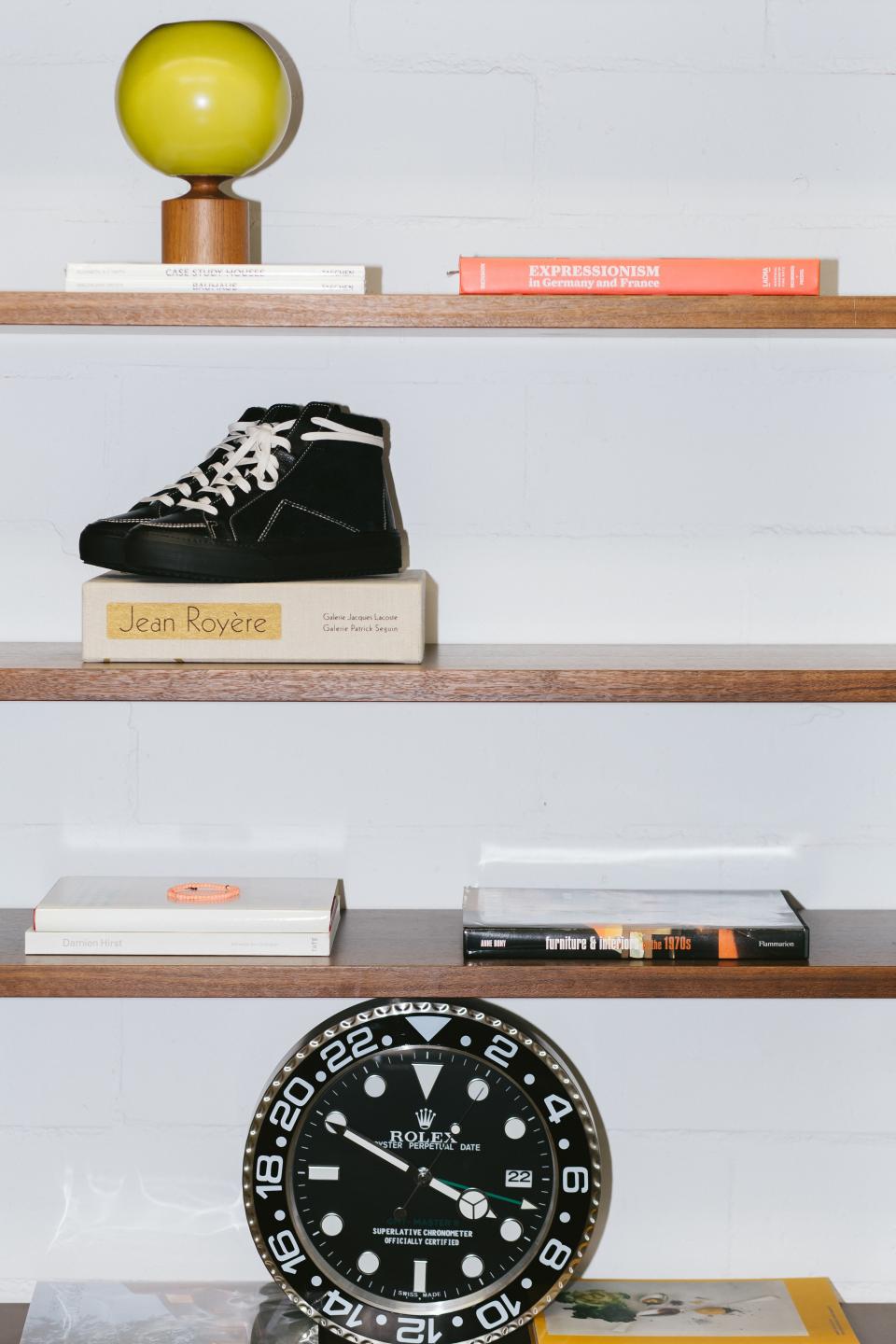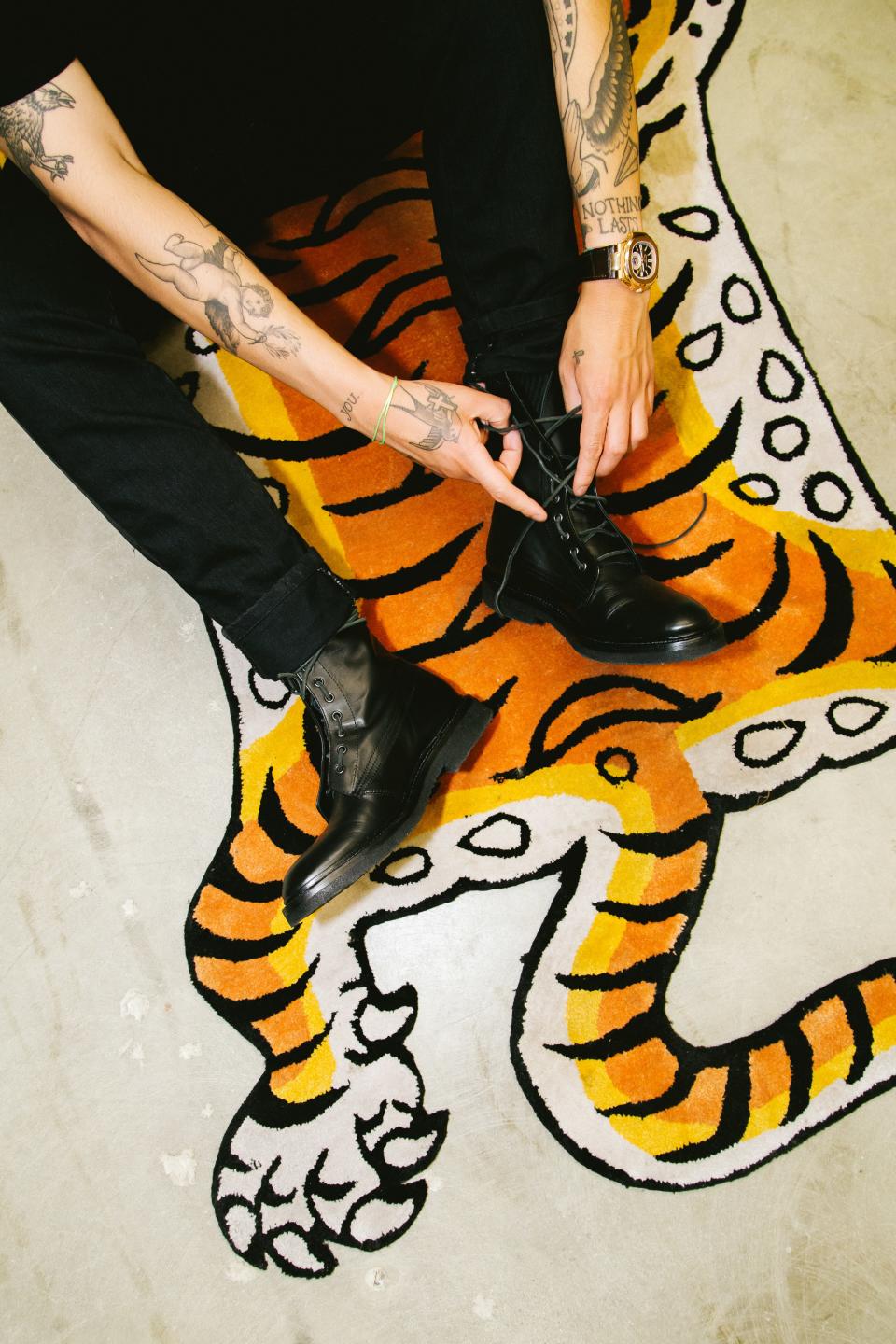Rhude Designer Rhuigi Villaseñor Is Making the Leap
Over the holidays, Rhude designer Rhuigi Villaseñor received a package from one of his best customers. Lately, it can feel like he is the exclusive couturier of the world’s most famous celebrities—LeBron James, Justin Bieber, Odell Beckham Jr., Dwyane Wade, Kevin Durant, Kelly Oubre Jr., Lewis Hamilton, Tristan Thompson, Lenny Kravitz, Ben Simmons, Michael B. Jordan, Kendrick Lamar, Meek Mill, and Nick Jonas are all fans. In other words: a dynasty-forming collection of NBA stars, the most exciting player in the NFL, and a handful of the globe’s most popular musicians. So you can only imagine the bejeweled or four-wheeled or croc-leather gift Rhuigi received. But no! The gift was something much more modest: cookies and a note from daytime television darling Ellen Degeneres.
The note, the contents of which Villasenor won’t divulge, is now framed in his house in Los Angeles. The cookies? “Oatmeal raisin,” he says. “They were good.” A small but telling prize for a guy whose line, while not a household name, has nonetheless come to be everywhere. Because in 2019, there is practically nothing more important to a successful brand than star-powered fandom—and maybe a couple cookies.
Celebrity support is the bedrock of Villasenor’s brand. In 2012, Kendrick Lamar wore a custom bandana-print T-shirt that Villasenor had designed as a teen to the Grammys. The next day he made $150,000 off orders of the same design.
Rhude has grown up a lot since it first appeared on stage with Lamar. Late last month, the brand put on its first runway show in Paris. For the first time, he presented sneakers—a logical fit for his burgeoning streetwear-leaning empire—alongside the less expected: boots, which he’s collected since high school. He wants to dive deeper into tailoring, and design furniture, too. “I would get so upset when I was labeled as a graphic streetwear brand, cause I saw it as something larger,” he explains. The show was about introducing that something larger—and connecting with an even bigger audience in the process.
Rhude is a brand seemingly tailor-made to succeed in a streetwear-crazy era in which paying hundreds of dollars for a graphic T-shirt is not just totally sane, it’s cool . Villasenor’s squawking eagles, Marlboro-inspired graphics, and signature “Traxedo” pants (that’s a mashup of tuxedo and track bottoms) were born to be worn on arena stages, in flex-demanding NBA arena tunnels stage, and shouted out by LeagueFits. The graphics are unmistakable, instantly conferring status.
And while Villasenor says he no longer sees $150,000 materialize in his account after every wear by a celebrity, he acknowledges the benefits, and realities, of a star-studded clientele—starting with those oatmeal-raisins. We spoke to Villasenor shortly after his Paris show about his famous fan base, why Virgil Abloh is like the Matrix’s Neo, and potentially designing for a European house one day.


GQ: This is your first time doing a show in Paris, right?
Villaseñor: First one, first presentation, official business. Scary.
What was the reason for doing a show there?
It felt right for the brand. We've been growing commercially and I thought that I needed to serve the vision of the company and, on a larger scale, that was going to support the business but also make tradition clear for the customers.
Your brand communicates with customers so directly through social media and Instagram. What was the need to do a physical show?
I had this vision of creating a new luxury, so to speak—this post-streetwear new luxury brand. And to support the business, you can't just depend on the internet and celebrities supporting that.
A show in Paris still feels like a pretty important business decision, then?
Absolutely. Obviously, it shocks the business, not just financially. It takes a lot of ammo, too. To produce the show, not to mention [producing one-off samples]. But yeah, I thought we were prepared, I thought we were ready.
What made this the right time?
Well, we've been selling and growing with retailers globally. The brand is getting stronger and sell-through is great. I thought this would strengthen it.
You mentioned a vision, what do you feel like that vision is, how would you articulate it?
Well, with this collection, first off, I didn't want to shock consumers or anyone new to the company. I wanted it to be an introduction to the body of work I've put in. From the old graphic tees that I've done and different silhouettes. And also suggesting that I want to grow this into something much more than just T-shirts and pants, opening categories that I feel like we're very comfortable with.
Sneakers is one of those, right?
Yeah, sneakers, the boots, and also leather goods.
Sneakers feels like a really natural extension for you and your brand—that just makes a ton of sense.
Yeah, exactly, but my partner is actually the one who was like, "We have to do sneakers." It's funny, because when we were developing, I was like, "All right, well, I'll design sneakers and stuff, but I'm going to head to boots immediately after this.”
What draws you to boots?
I've been collecting loafers, boots even, since high school. I really couldn't even explain why I like it, but it's just what I collect. But, for footwear, the reason, it's got that vintage flea market kind of feel that’s still very true to ourselves. I want something that's really authentic.
Were you ever worried that you were going to get pegged as just a T-shirt brand?
That was never really a worry. I've always been clear of what my talents are, and my background, but, it's just… you never want to stay too long at the party, right?

We just did an interview with Bobby Hundreds, and he was on top of the world at one point. He talks about how people would come up to him and say, "You're the new Supreme, you're the new Ralph Lauren," and now obviously he’s in a really different place. I wonder: you're incredibly hot right now, do you worry about sustaining that, or do you think about how you can kind of keep that momentum going and keep building?
That's been on our minds, and it's just full preparations for everything. But I think that happens when you lose excitement for the clothes. And there's also natural things you can't stop—it's just people's behavior. Sometimes the wind blows in a way that we never thought it would. But I've been fortunate enough to have this steady growth. It doesn't really worry me, but it's in my head.
Is part of that why you want to do furniture design? Does that protect you against that happening?
No, just as I keep going further, I want to make a clear statement of what my world looks like, and who my guy is and this commonality and this acquired taste my consumers have. And it’s spaces that I know that I'm very comfortable with and knowledgeable about. So I thought it would make sense. And I already think about furniture when I design clothes, and I think about what's this guy driving, what kind of chair is he sitting in?
What sort of chair does the Rhude guy sit on?
It's wooden, it's definitely wooden, and handmade, but with a hint of brass and age.
Can you speak about your design process? I was just watching this video and you were on a Microsoft tablet drawing around this print.
I'm a pen and paper guy. I draw, I can trace well. I know construction and tailoring, too, because I studied that.In our office I've never wanted to be too serious—I explore the consumer, and we have these conversations. I'll wake up and I have these just random questions, random theories, and I’ll ask even our cleaning lady what she thinks about something because I value everyone's opinion. And then we have a conversation and then I explore the different ideas, whether it be immigration, or rodeo, or even just comfortability on like why you chose what you wore today. Then I control color pallette, color shearings, and I build a narrative story of what this collection really is. It's like writing a book to me.
You'll ask random people why they chose what they wore today?
Yeah, because it's important to understand human behavior.
What are you trying to learn? Or are you trying to see what motivates people to buy the clothing that they buy?
Yeah, what motivates them. As much of an artist [as] I am, I also have a firm understanding of how important it is to have commercial support. So, I try to find a medium between that.
Speaking of your commercial success, I wonder when you felt that Rhude was really taking off in a huge way?
When I would be outside, and I would see people wearing my clothes without people really knowing who I was. I think that's indicative that people are buying the product or the design. And we've been delivering previous seasons now and I see the numbers, even though I try not to.
I try to have my hands on everything, but my partner's like, "I don't want you looking at the numbers cause you'll alter your decisions." But I'm very trained in my mind on how I react to things. So I look at the numbers and I’m like: Okay, this is a stable business, and I think it's something we could sustain and continuously do. So now, let's start to introduce what it is that I had the clear vision [to do] from the beginning.
You feel like you've sort of have been building up to this moment the whole time?
Yeah. When I was making those bandana tees, I already perceived myself to be on this mission, or wherever I'm headed. That's why I would get so upset when I was labeled as a graphic streetwear brand because I saw it as something larger.
I feel like in every interview Kendrick Lamar wearing the bandana tee to the Grammys comes back.
It always comes back, you know?
Obviously that must have been huge when that happened, but at some point did you say, "I have to evolve beyond that?”
Yeah, and even when I hear it now—I used to feel negative ways about it, but it's part of my history and I can't run away from that.
Why do you say you felt negatively?
It's just like... the time that I made that decision is so long ago. I was a teen when I designed that shirt, and then waited and waited years to produce it.
I see celebrities in your clothes almost daily now—what does that feel like for you?
To me, it's an honor because we don't really—we started off not doing any seeding. When I see any public figure wearing it, it's an honor because they spent their well-earned money. And they don't have to do that. I've seen the choices that they have, I've seen the amount of product that gets thrown at them, so for them to choose to wear that, it means more to me than anything. But I hold the same value to LeBron James, or Justin Bieber, or Ellen DeGeneres as the kid who buys it. That was me when I collected every lunch money I had to buy my first Bape T-shirt. To me they're all equally important.

Is there someone memorable from the past year that you were particularly excited about?
I always love when Ellen buys it. To me, it's just so... there's humor in that—I don't know—that Ellen DeGeneres loves my clothes.
I didn’t know Ellen was a loyal customer.
She knows what's up. She likes the jacket, she likes the pants. I was like, "Um, okay, cool, let's do this." When I first got the word I was like, "Are you serious?" And you're put in a position where you're like, “Is someone playing around with me?”
Have you talked to her at all?
She sent over a letter and some cookies during the holidays, so that was nice. I got that framed in my house.
That's nice. What does the letter say?
It's framed in my house. It's framed in my house. I was like, "Do I eat these cookies or do I frame them too?"
Do you have a sense for why celebrities gravitate so much to your clothes?
I don't know. Sometimes I think it's nostalgia, or maybe it's yearning for something new? But, yeah, they buy. Their behavior is different—some buy it for the fit, some buy it for the graphics. I get strong compliments [on] my graphics. Maybe it's that? Because we all come from a similar background of buying streetwear T-shirts and I just am kind of offering something post-that.
How important is it, running a brand in 2019, to have that sort of support from celebrities?
I think it's great that they like it, but I think great design and great product sells more than any marketing.
You don't want to lean on that too much.
I think that we're smart for that. You just have to strive to improve the product that you make and then you allow people to follow through to it, you know?
When you see something like Virgil Abloh getting the Louis Vuitton job, what hope does that give you for your brand and the way streetwear is seen today?
For it to be one of my peers getting [the Louis Vuitton] job was kind of breaking the barrier. He's like Neo to this. Right, right? He's Neo to this, he's the birth child of all of this. I said this after his first show, there was a luncheon or dinner after, and I expressed to them that I feel that I am the post-guinea pig case-study of the generation after all of that. Because I was growing up studying what they were doing and now I'm creating something that's within the same realm but is a little bit different.
Do you dream of running one of these European luxury houses? Is that something you want to do, or are you solely focused on your brand?
Yes. Honest, completely honest? Yeah, of course. I think I have a vision for a couple houses. But moreso, my focus is the brand, I think this is a reflection of me.
Originally Appeared on GQ

